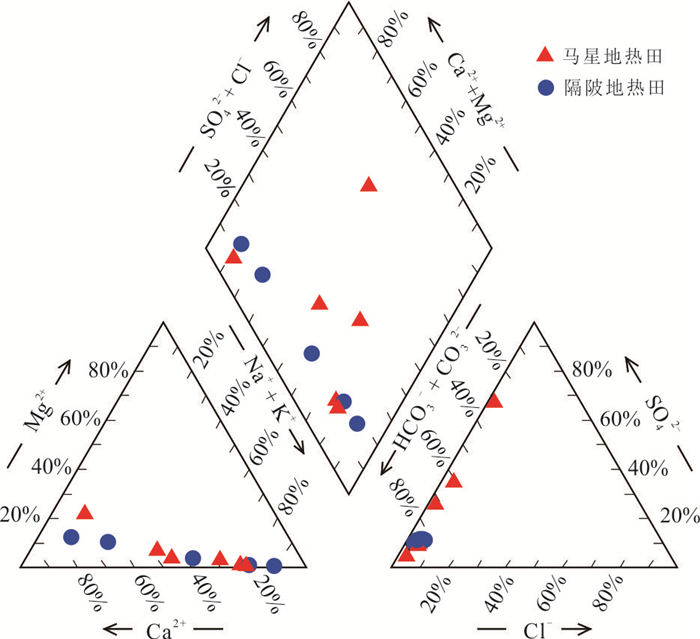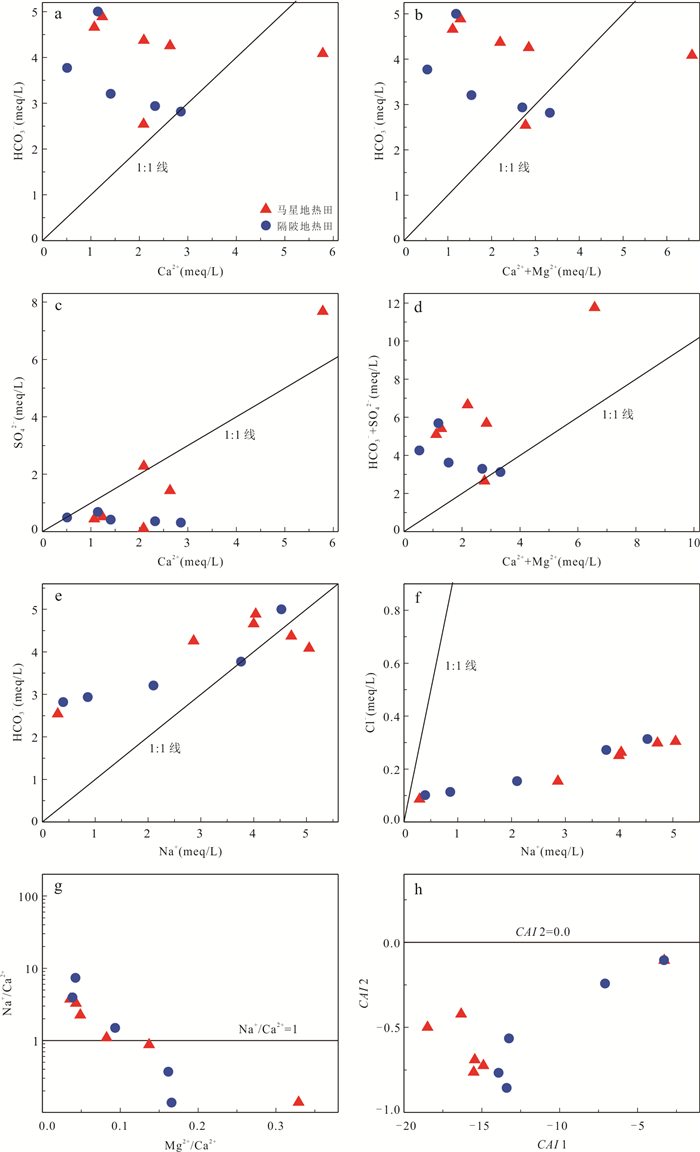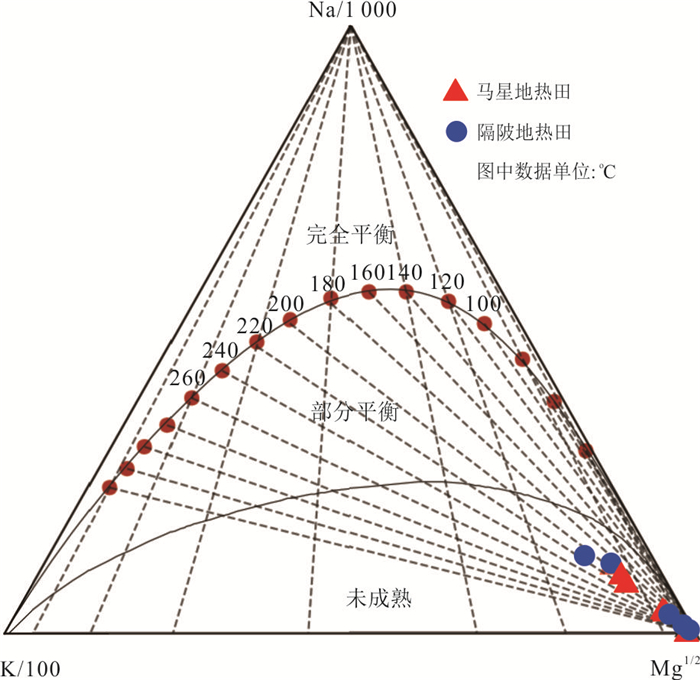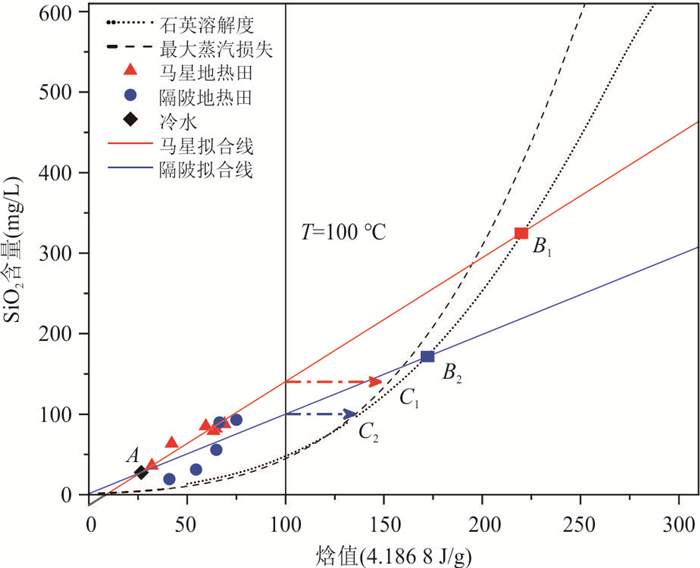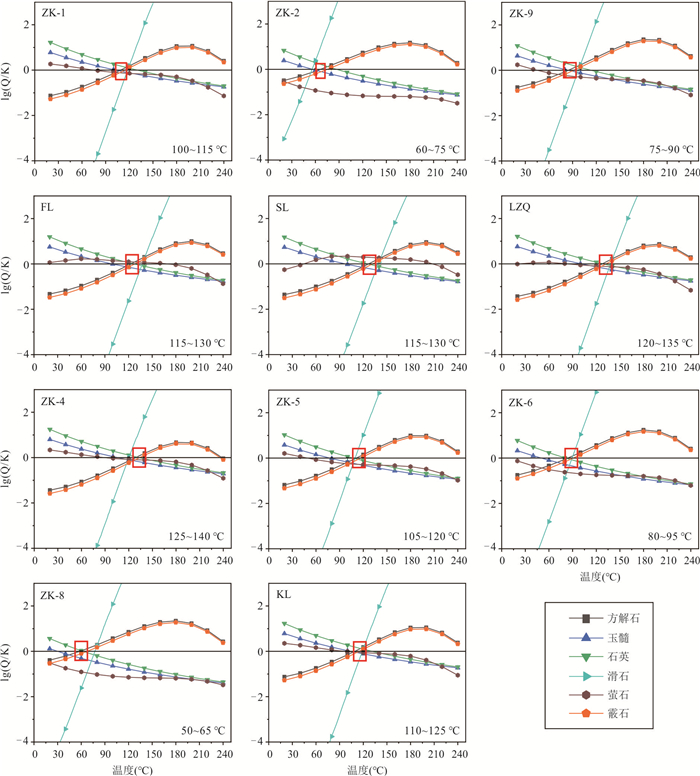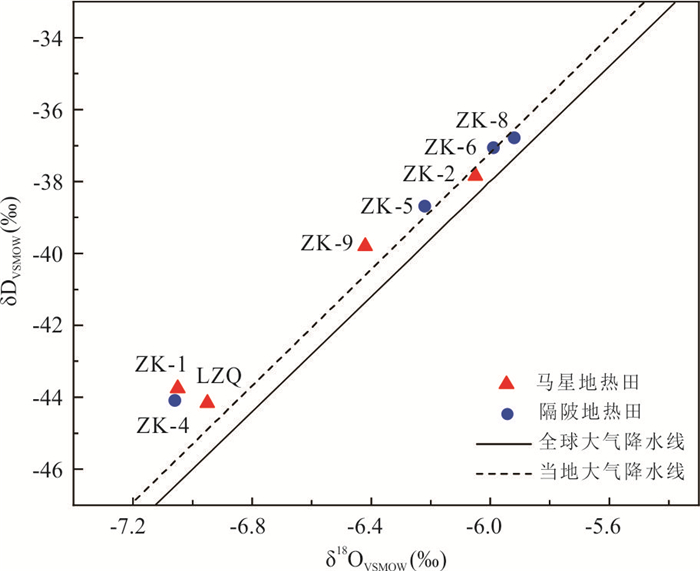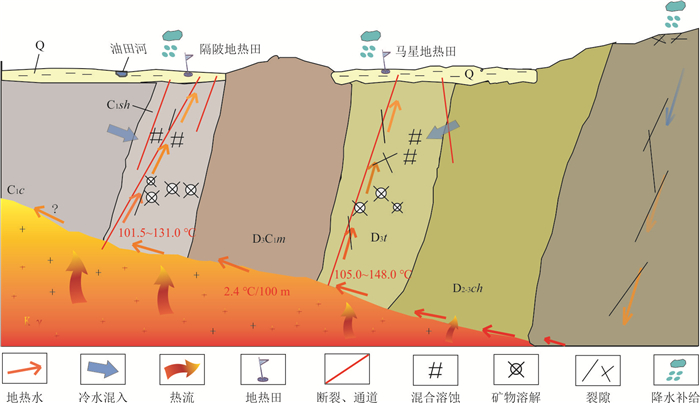Geothermometry Calculation and Geothermal Fluid Evolution of Karst Geothermal Reservoir in Longmen County, Guangdong Province
-
摘要: 岩溶地热系统具有巨大的能源开发潜力,广东省龙门县马星和隔陂地热异常区是两个典型的岩溶地热田.为探究热储温度及流体演化特征,基于离子比值关系、氘氧同位素、地温计等方法对其进行分析讨论.结果表明研究区为中性偏碱性低TDS的HCO3型地热水,方解石类碳酸盐矿物和硅酸盐矿物溶解及阳离子交换作用共同控制了水化学演化过程.大气降水是区内地热水的主要补给来源,马星和隔陂地热田的热储温度分别约为105.0~148.0 ℃和101.5~131.0 ℃,冷水混入的体积比约为44.2%和48.5%.在热储水化学及温度特征的基础上,建立了流体演化概念模型.Abstract: Karst geothermal systems hold enormous potential for geothermal exploitation. The Maxing and Gepi geothermal anomaly areas are typical geothermal fields in Longmen County, Guangdong Province. The temperature and fluid evolution of geothermal reservoir can be clarified, with the analysis of ion ratio relationship, δD and δ18O isotopes, and geothermal thermometers et.al. It is indicated that silicate minerals, carbonate minerals such as calcite dissolution, and accompanying cation exchange control the hydrochemistry evolution, thus forming slightly alkaline HCO3-type geothermal water with lower TDS in the study area. The results suggest that atmospheric precipitation is the main recharge source. The reservoir temperature is 105.0-148.0 ℃ and 101.5-131.0 ℃ for Maxing and Gepi geothermal reservoir respectively, with a lower temperature during upwelling caused by mixing with cold water up to 44.2% and 48.5% dilution. In this case, a conceptual model for geothermal fluid evolution is proposed based on the geothermal water hydrochemistry and reservoir temperature characteristics.
-
图 3 地热水主要离子关系
$ { CAI }\; 1=\left[\mathrm{Cl}^{-}-\left(\mathrm{Na}^{+}+\mathrm{K}^{+}\right)\right] / \mathrm{Cl}^{-}, {CAI }\; 2=\left[\mathrm{Cl}^{-}-\left(\mathrm{Na}^{+}+\mathrm{K}^{+}\right)\right] /\left[\mathrm{SO}_4^{2-}+\mathrm{HCO}_3^{-}+\mathrm{CO}_3{ }^{2-}+\mathrm{NO}_3^{-}\right]$
Fig. 3. Major ion ratio relation of geothermal waters
表 1 马星和隔陂地热水位置及水化学特征
Table 1. Location and water chemistry information of geothermal water in Maxing and Gepi
马星地热田 隔陂地热田 ZK-1 ZK-2 ZK-9 FL SL LZQ ZK-4 ZK-5 ZK-6 ZK-8 KL 纬度(北纬) 23°34′10″ 23°34′10″ 23°34′14″ 23°34′11″ 23°34′8″ 23°34′13″ 23°34′27″ 23°34′31″ 23°34′31″ 23°34′32″ 23°34′56″ 经度(东经) 113°59′51″ 113°59′58″ 113°59′54″ 113°59′46″ 113°59′4″ 113°59′50″ 113°59′18″ 113°59′13″ 113°59′18″ 113°59′17″ 113°59′36″ 实测温度(℃) 69.0 32.0 42.1 64.5 63.4 59.4 75.0 64.8 54.5 40.9 66.4 pH 7.58 7.81 7.56 7.36 7.07 7.51 7.91 7.66 7.68 7.83 7.92 TDS (mg/L) 180.2 84.6 181.3 233.0 367.0 169.5 159.2 129.8 108.3 99.1 193.1 DO (mg/L) 4.33 3.71 4.47 3.37 4.31 3.57 3.48 3.89 3.94 4.91 4.30 ORP (mV) 294.2 208.2 244.4 296.5 226.6 208.4 241.2 293.1 275.1 223.7 231.6 COND(μS/cm) 375 178 376 480 751 352 392 312 260 235 402 Ca2+ (mg/L) 24.72 41.77 52.66 41.86 115.70 21.45 10.21 28.18 46.48 57.08 22.88 K+ (mg/L) 5.60 3.01 5.09 7.34 8.74 5.66 6.28 3.91 2.32 1.60 5.93 Mg2+(mg/L) 0.64 8.25 2.61 1.22 9.51 0.46 0.26 1.58 4.51 5.68 0.53 Na+ (mg/L) 92.89 6.70 65.87 108.40 116.20 91.99 86.50 48.37 19.77 9.07 104.10 Si (mg/L) 40.93 16.80 29.63 38.43 37.00 39.75 43.43 26.04 14.60 9.00 41.90 F‒ (mg/L) 8.39 1.91 4.75 9.27 8.61 9.43 13.45 6.29 2.97 1.71 9.77 Cl‒ (mg/L) 9.34 3.06 5.46 10.58 10.81 8.91 9.66 5.49 4.04 3.59 11.13 SO42 ‒(mg/L) 24.85 5.50 68.65 109.40 368.30 21.20 23.65 20.03 17.38 15.06 33.05 HCO3‒(mg/L) 298.2 155.0 259.5 266.6 249.2 284.1 230.0 195.7 179.2 171.7 305.1 δ18OVSMOW (‰) ‒7.05 ‒6.05 ‒6.42 / / ‒6.95 ‒7.06 ‒6.22 ‒5.99 ‒5.92 / δDVSMOW (‰) ‒43.75 ‒37.84 ‒39.80 / / ‒44.16 ‒44.09 ‒38.69 ‒37.06 ‒36.78 / 注:“/”为未检测. 表 2 马星和隔陂地热田水样矿物饱和指数
Table 2. Mineral saturation index (SI) of geothermal water samples in Maxing and Gepi
采样点 水样 方解石 盐岩 白云石 硬石膏 石膏 玉髓 石英 马星地
热田ZK-1 0.59 ‒7.73 0.06 ‒2.43 ‒2.54 0.26 0.57 ZK-2 0.38 ‒9.26 0.47 ‒3.17 ‒2.98 0.24 0.65 ZK-9 0.50 ‒8.06 0.18 ‒2.00 ‒1.87 0.51 0.89 FL 0.45 ‒7.61 ‒0.18 ‒1.70 ‒1.76 0.33 0.65 SL 0.45 ‒7.60 0.25 ‒0.93 ‒0.98 ‒0.13 0.20 LZQ 0.35 ‒7.73 ‒0.46 ‒2.66 ‒2.67 ‒0.31 0.03 隔陂地热田 ZK-4 0.48 ‒7.72 ‒0.17 ‒2.72 ‒2.89 0.06 0.35 ZK-5 0.53 ‒8.22 0.30 ‒2.48 ‒2.54 0.27 0.59 ZK-6 0.61 ‒8.72 0.72 ‒2.47 ‒2.44 0.41 0.75 ZK-8 0.66 ‒9.09 0.80 ‒2.58 ‒2.44 0.49 0.87 KL 0.84 ‒7.60 0.54 ‒2.40 ‒2.49 0.08 0.40 -
Arnórsson, S., 1983. Chemical Equilibria in Icelandic Geothermal Systems-Implications for Chemical Geothermometry Investigations. Geothermics, 12(2-3): 119-128. https://doi.org/10.1016/0375-6505(83)90022-6 Aydin, H., Karakuş, H., Mutlu, H., 2020. Hydrogeochemistry of Geothermal Waters in Eastern Turkey: Geochemical and Isotopic Constraints on Water-Rock Interaction. Journal of Volcanology and Geothermal Research, 390: 106708. https://doi.org/10.1016/j.jvolgeores.2019.106708 Blasco, M., Gimeno, M. J., Auqué, L. F., 2018. Low Temperature Geothermal Systems in Carbonate-Evaporitic Rocks: Mineral Equilibria Assumptions and Geothermometrical Calculations. Insights from the Arnedillo Thermal Waters (Spain). Science of the Total Environment, 615: 526-539. https://doi.org/10.1016/j.scitotenv.2017.09.269 Chen, D., Niu, H. L., 2021. Geological Characteristics and Geothermal Exploration Direction in Yonghan Area, Longmen, Guangdong Province. Western Resources, (3): 169-171 (in Chinese with English abstract). Craig, H., 1961. Isotopic Variations in Meteoric Waters. Science, 133(3465): 1702-1703. https://doi.org/10.1126/science.133.3465.1702 Ding, X., Su, K. L., Yan, H. B., et al., 2022. Effect of F-Rich Fluids on the A-Type Magmatism and Related Metal Mobilization: New Insights from the Fogang-Nankunshan-Yajishan Igneous Rocks in Southeast China. Journal of Earth Science, 33(3): 591-608. https://doi.org/10.1007/s12583-022-1611-7 Fournier, R. O., 1977. Chemical Geothermometers and Mixing Models for Geothermal Systems. Geothermics, 5(1-4): 41-50. https://doi.org/10.1016/0375-6505(77)90007-4 Fu, C. C., Li, X. Q., Ma, J. F., et al., 2018. A Hydrochemistry and Multi-Isotopic Study of Groundwater Origin and Hydrochemical Evolution in the Middle Reaches of the Kuye River Basin. Applied Geochemistry, 98: 82-93. https://doi.org/10.1016/j.apgeochem.2018.08.030 Giggenbach, W. F., 1988. Geothermal Solute Equilibria. Derivation of Na-K-Mg-Ca Geoindicators. Geochimica et Cosmochimica Acta, 52(12): 2749-2765. https://doi.org/10.1016/0016-7037(88)90143-3 Goldscheider, N., Mádl-Szőnyi, J., Erőss, A., et al., 2010. Review: Thermal Water Resources in Carbonate Rock Aquifers. Hydrogeology Journal, 18(6): 1303-1318. https://doi.org/10.1007/s10040-010-0611-3 Guo, Q., Pang, Z. H., Wang, Y. C., et al., 2017. Fluid Geochemistry and Geothermometry Applications of the Kangding High-Temperature Geothermal System in Eastern Himalayas. Applied Geochemistry, 81: 63-75. https://doi.org/10.1016/j.apgeochem.2017.03.007 He, P. X., 2019. Hydrochemical Characteristics and Genesis of Thermal Fluid in a Covered Karst Geothermal Field in Longmen County, Huizhou City, Guangdong Province. Western Resources, (2): 62-64 (in Chinese with English abstract). Jiang, Y., Li, J., Xing, Y. F., et al., 2023. Evaluation of Geochemical Geothermometers with Borehole Geothermal Measurements: A Case Study of the Xiong'an New Area. Earth Science, 48(3): 958-972. (in Chinese with English abstract). Li, J. X., Sagoe, G., Li, Y. L., 2020. Applicability and Limitations of Potassium-Related Classical Geothermometers for Crystalline Basement Reservoirs. Geothermics, 84: 101728. https://doi.org/10.1016/j.geothermics.2019.101728 Li, J. X., Sagoe, G., Yang, G., et al., 2018. Evaluation of Mineral-Aqueous Chemical Equilibria of Felsic Reservoirs with Low-Medium Temperature: A Comparative Study in Yangbajing Geothermal Field and Guangdong Geothermal Fields. Journal of Volcanology and Geothermal Research, 352: 92-105. https://doi.org/10.1016/j.jvolgeores.2018.01.008 Li, J. X., Wu, Z. H., Tian, G. H., et al., 2022. Processes Controlling the Hydrochemical Composition of Geothermal Fluids in the Sandstone and Dolostone Reservoirs Beneath the Sedimentary Basin in North China. Applied Geochemistry, 138: 105211. https://doi.org/10.1016/j.apgeochem.2022.105211 Lin, W. J., Wang, G. L., Gan, H. N., et al., 2022. Heat Generation and Accumulation for Hot Dry Rock Resources in the Igneous Rock Distribution Areas of Southeastern China. Lithosphere, 2021(Special 5): 2039112. https://doi.org/10.2113/2022/2039112 Luo, J., Li, Y. M., Tian, J. A., et al., 2022. Geochemistry of Geothermal Fluid with Implications on Circulation and Evolution in Fengshun-Tangkeng Geothermal Field, South China. Geothermics, 100: 102323. https://doi.org/10.1016/j.geothermics.2021.102323 Mao, X. M., Zhu, D. B., Ndikubwimana, I., et al., 2021. The Mechanism of High-Salinity Thermal Groundwater in Xinzhou Geothermal Field, South China: Insight from Water Chemistry and Stable Isotopes. Journal of Hydrology, 593: 125889. https://doi.org/10.1016/j.jhydrol.2020.125889 Pang, Z. H., Reed, M., 1998. Theoretical Chemical Thermometry on Geothermal Waters: Problems and Methods. Geochimica et Cosmochimica Acta, 62(6): 1083-1091. https://doi.org/10.1016/S0016-7037(98)00037-4 Pang, Z. H., Kong, Y. L., Li, J., et al., 2017. An Isotopic Geoindicator in the Hydrological Cycle. Procedia Earth and Planetary Science, 17: 534-537. https://doi.org/10.1016/j.proeps.2016.12.135 Qiu, X. L., Wang, Y., Wang, Z. Z., et al., 2018. Determining the Origin, Circulation Path and Residence Time of Geothermal Groundwater Using Multiple Isotopic Techniques in the Heyuan Fault Zone of Southern China. Journal of Hydrology, 567: 339-350. https://doi.org/10.1016/j.jhydrol.2018.10.010 Reed, M., Spycher, N., 1984. Calculation of pH and Mineral Equilibria in Hydrothermal Waters with Application to Geothermometry and Studies of Boiling and Dilution. Geochimica et Cosmochimica Acta, 48(7): 1479-1492. https://doi.org/10.1016/0016-7037(84)90404-6 Shi, Z. D., Mao, X. M., Ye, J. Q., et al., 2024. Analysis of Source of Sodium of Low-Salinity High-Sodium Geothermal Water in Huangshadong Geothermal Field from the East Guangdong. Earth Science, 49(1): 288-298 (in Chinese with English abstract). Sun, H. Y., Sun, X. M., Wei, X. F., et al., 2023. Geochemical Characteristics and Origin of Nuanquanzi Geothermal Water in Yudaokou, Chengde, Hebei, North China. Journal of Earth Science, 34(3): 838-856. https://doi.org/10.1007/s12583-022-1635-z Wang, J. L., Jin, M. G., Jia, B. J., et al., 2015. Hydrochemical Characteristics and Geothermometry Applications of Thermal Groundwater in Northern Jinan, Shandong, China. Geothermics, 57: 185-195. https://doi.org/10.1016/j.geothermics.2015.07.002 Wang, S. A., Kuang, J. A., Huang, X. L., et al., 2022. Upwelling of Mantle-Derived Material in Southeast China: Evidence from Noble Gas Isotopes. Acta Geologica Sinica-English Edition, 96(1): 100-110. https://doi.org/10.1111/1755-6724.14686 Wang, X. A., Lu, G. P., Hu, B. X., 2018. Hydrogeochemical Characteristics and Geothermometry Applications of Thermal Waters in Coastal Xinzhou and Shenzao Geothermal Fields, Guangdong, China. Geofluids, 2018: 1-24. https://doi.org/10.1155/2018/8715080 Xi, Y. F., Wang, G. L., Liu, S., et al., 2018. The Formation of a Geothermal Anomaly and Extensional Structures in Guangdong, China: Evidence from Gravity Analyses. Geothermics, 72: 225-231. https://doi.org/10.1016/j.geothermics.2017.11.009 Xiao, Z. C., Wang, S., Qi, S. H., et al., 2020. Petrogenesis, Tectonic Evolution and Geothermal Implications of Mesozoic Granites in the Huangshadong Geothermal Field, South China. Journal of Earth Science, 31(1): 141-158. https://doi.org/10.1007/s12583-019-1242-9 Xiao, Z. C., Wang, S., Qi, S. H., et al., 2023. Crustal Thermo-Structure and Geothermal Implication of the Huangshadong Geothermal Field in Guangdong Province. Journal of Earth Science, 34(1): 194-204. https://doi.org/10.1007/s12583-021-1486-z Xu, Z. K., Xu, S. G., Zhang, S. T., 2021. Hydro-Geochemistry of Anning Geothermal Field and Flow Channels Inferring of Upper Geothermal Reservoir. Earth Science, 46(11): 4175-4187 (in Chinese with English abstract). Yan, X. X., Gan, H. N., Yue, G. F., 2019. Hydrogeochemical Characteristics and Genesis of Typical Geothermal Fileds from Huangshadong to Conghua in Guangdong. Geological Review, 65(3): 743-754 (in Chinese) Yan, X. X., Lin, W. J., Gan, H. N., et al., 2019. Hydrogeochemical Characteristics of Huangshadong Geothermal Filed in Guangdong. IOP Conference Series: Earth and Environmental Science, 237: 032128. https://doi.org/10.1088/1755-1315/237/3/032128 Yang, P. H., Dan, L., Groves, C., et al., 2019a. Geochemistry and Genesis of Geothermal Well Water from a Carbonate-Evaporite Aquifer in Chongqing, SW China. Environmental Earth Sciences, 78(1): 33. https://doi.org/10.1007/s12665-018-8004-3 Yang, P. H., Luo, D., Hong, A. H., et al., 2019b. Hydrogeochemistry and Geothermometry of the Carbonate-Evaporite Aquifers Controlled by Deep-Seated Faults Using Major Ions and Environmental Isotopes. Journal of Hydrology, 579: 124116. https://doi.org/10.1016/j.jhydrol.2019.124116 Zhang, M., Kuang, J., Xiao, Z. C., et al., 2021. Geological Evolution since the Yanshanian in Huizhou, Guangdong Province: New Implications for the Tectonics of South China. Earth Science, 46(1): 242-258 (in Chinese with English abstract). Zhang, Y., Luo, J., Feng, J. Y., 2020. Characteristics of Geothermal Reservoirs and Utilization of Geothermal Resources in the Southeastern Coastal Areas of China. Journal of Groundwater Science and Engineering, 8(2): 134-142. https://doi.org/10.19637/j.cnki.2305-7068.2020.02.005 Zhou, Z. M., Ma, C. Q., Qi, S. H., et al., 2020. Late Mesozoic High-Heat-Producing (HHP) and High- Temperature Geothermal Reservoir Granitoids: The most Significant Geothermal Mechanism in South China. Lithos, 366-367: 105568. https://doi.org/10.1016/j.lithos.2020.105568 Zhu, X., Wang, G. L., Ma, F., et al., 2021. Hydrogeochemistry of Geothermal Waters from Taihang Mountain-Xiongan New Area and Its Indicating Significance. Earth Science, 46(7): 2594-2608 (in Chinese with English abstract). 陈东, 牛慧麟, 2021. 广东龙门永汉地区地质特征及地热勘探方向. 西部资源, (3): 169-171. https://www.cnki.com.cn/Article/CJFDTOTAL-XBZY202103059.htm 何沛欣, 2019. 广东省惠州市龙门县某覆盖型岩溶地热田地热流体水化学特征及其成因. 西部资源, (2): 62-64. https://www.cnki.com.cn/Article/CJFDTOTAL-XBZY201902030.htm 姜颖, 李捷, 邢一飞, 等, 2023. 基于钻孔测温的地球化学温度计适宜性评价: 以雄安新区为例. 地球科学, 48(3): 958-972. doi: 10.3799/dqkx.2022.385 史自德, 毛绪美, 叶建桥, 等, 2024. 中低温地热系统低盐度地热水高含量钠的地球化学成因研究: 以广东惠州黄沙洞地热田为例. 地球科学, 49(1): 288-298. doi: 10.3799/dqkx.2022.170 徐梓矿, 徐世光, 张世涛, 2021. 安宁地热田浅部热储水化学特征及补给通道位置. 地球科学, 46(11): 4175-4187. doi: 10.3799/dqkx.2020.401 闫晓雪, 甘浩男, 岳高凡, 2019. 广东惠州‒从化典型地热田水文地球化学特征及成因分析. 地质论评, 65(3): 743-754. https://www.cnki.com.cn/Article/CJFDTOTAL-DZLP201903020.htm 张敏, 旷健, 肖志才, 等, 2021. 广东惠州燕山期以来地质构造演化: 对华南构造的新启示. 地球科学, 46(1): 242-258. doi: 10.3799/dqkx.2020.016 朱喜, 王贵玲, 马峰, 等, 2021. 太行山‒雄安新区蓟县系含水层水文地球化学特征及意义. 地球科学, 46(7): 2594-2608. doi: 10.3799/dqkx.2020.207 -









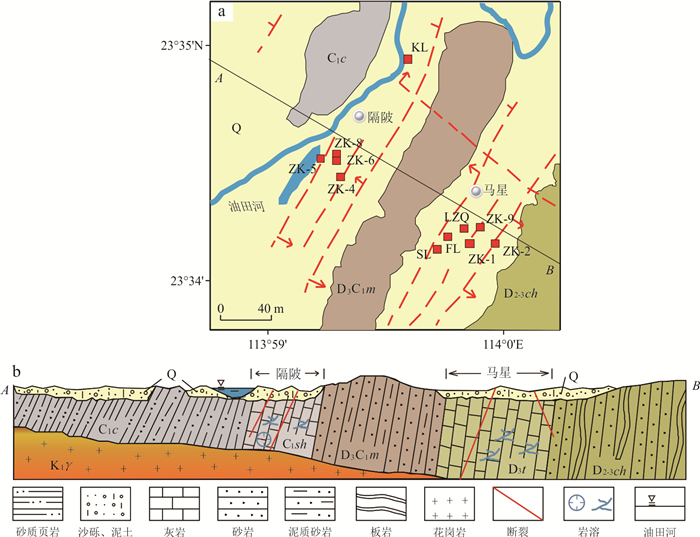
 下载:
下载:
